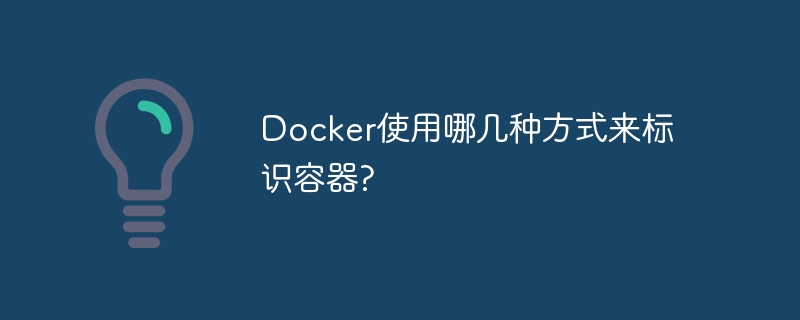What methods does Docker use to identify containers?
Docker identifies a container by: Container name: Unique identifier, specified at creation. Container ID: A unique identifier generated by Docker. Summary: A unique identifier generated based on image content. Tags: Key-value pairs, used to organize and identify containers. Extended Network Alias: A unique alias used to find between multiple containers. Docker Swarm service name: The name of the service collection that refers to a specific container. Docker Engine API: Allows reference to containers by name, ID, or digest.

How Docker identifies containers
Docker provides a variety of ways to identify containers, including:
1. Container name
The container name is a unique identifier, specified when creating the container. It must comply with the following rules:
- Length between 1 and 63 characters
- Only include lowercase letters, numbers, underscores and hyphens
- Can't start with numbers
- Must be unique
2. Container ID
The container ID is a long string generated by Docker. It is a unique identifier for the container, even if the container has been stopped or deleted.
3. Summary
A summary is a unique identifier used to identify the container image. It is generated based on the content of the image, including code, libraries, and dependencies.
4. Tags
Tags are key-value pairs used to organize and identify containers. They can be attached to the container image and to the container itself.
5. Extended network alias
In Docker Compose, you can specify an extended network alias for the container. These aliases can be used between multiple containers to facilitate discovery of each other.
6. Docker Swarm Service Name
In Docker Swarm, a service is a collection of container groups. A specific container can be referenced based on the service name.
7. Docker Engine API
The container can be referenced using the container name, ID, or digest through the Docker Engine API.
The above is the detailed content of What methods does Docker use to identify containers?. For more information, please follow other related articles on the PHP Chinese website!

Hot AI Tools

Undresser.AI Undress
AI-powered app for creating realistic nude photos

AI Clothes Remover
Online AI tool for removing clothes from photos.

Undress AI Tool
Undress images for free

Clothoff.io
AI clothes remover

Video Face Swap
Swap faces in any video effortlessly with our completely free AI face swap tool!

Hot Article

Hot Tools

Notepad++7.3.1
Easy-to-use and free code editor

SublimeText3 Chinese version
Chinese version, very easy to use

Zend Studio 13.0.1
Powerful PHP integrated development environment

Dreamweaver CS6
Visual web development tools

SublimeText3 Mac version
God-level code editing software (SublimeText3)

Hot Topics
 How to exit the container by docker
Apr 15, 2025 pm 12:15 PM
How to exit the container by docker
Apr 15, 2025 pm 12:15 PM
Four ways to exit Docker container: Use Ctrl D in the container terminal Enter exit command in the container terminal Use docker stop <container_name> Command Use docker kill <container_name> command in the host terminal (force exit)
 How to check the name of the docker container
Apr 15, 2025 pm 12:21 PM
How to check the name of the docker container
Apr 15, 2025 pm 12:21 PM
You can query the Docker container name by following the steps: List all containers (docker ps). Filter the container list (using the grep command). Gets the container name (located in the "NAMES" column).
 How to copy files in docker to outside
Apr 15, 2025 pm 12:12 PM
How to copy files in docker to outside
Apr 15, 2025 pm 12:12 PM
Methods for copying files to external hosts in Docker: Use the docker cp command: Execute docker cp [Options] <Container Path> <Host Path>. Using data volumes: Create a directory on the host, and use the -v parameter to mount the directory into the container when creating the container to achieve bidirectional file synchronization.
 How to restart docker
Apr 15, 2025 pm 12:06 PM
How to restart docker
Apr 15, 2025 pm 12:06 PM
How to restart the Docker container: get the container ID (docker ps); stop the container (docker stop <container_id>); start the container (docker start <container_id>); verify that the restart is successful (docker ps). Other methods: Docker Compose (docker-compose restart) or Docker API (see Docker documentation).
 How to start mysql by docker
Apr 15, 2025 pm 12:09 PM
How to start mysql by docker
Apr 15, 2025 pm 12:09 PM
The process of starting MySQL in Docker consists of the following steps: Pull the MySQL image to create and start the container, set the root user password, and map the port verification connection Create the database and the user grants all permissions to the database
 How to update the image of docker
Apr 15, 2025 pm 12:03 PM
How to update the image of docker
Apr 15, 2025 pm 12:03 PM
The steps to update a Docker image are as follows: Pull the latest image tag New image Delete the old image for a specific tag (optional) Restart the container (if needed)
 How to start containers by docker
Apr 15, 2025 pm 12:27 PM
How to start containers by docker
Apr 15, 2025 pm 12:27 PM
Docker container startup steps: Pull the container image: Run "docker pull [mirror name]". Create a container: Use "docker create [options] [mirror name] [commands and parameters]". Start the container: Execute "docker start [Container name or ID]". Check container status: Verify that the container is running with "docker ps".
 How to create containers for docker
Apr 15, 2025 pm 12:18 PM
How to create containers for docker
Apr 15, 2025 pm 12:18 PM
Create a container in Docker: 1. Pull the image: docker pull [mirror name] 2. Create a container: docker run [Options] [mirror name] [Command] 3. Start the container: docker start [Container name]






